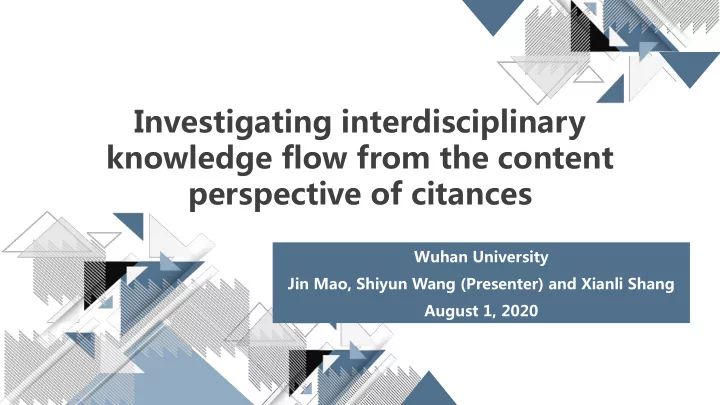

Investigating interdisciplinary knowledge flow from the content perspective of citances Wuhan University Jin Mao, Shiyun Wang (Presenter) and Xianli Shang August 1, 2020
Introduction Interdisciplinary knowledge integration Interdisciplinary knowledge flow Citation analysis Discipline 1 Discipline 2 Related Interdiscipli- Disciplines nary field Methods Theories Interdisci- Tools plinary research ◇ Conventionally, the knowledge flow to a Discipline 4 Discipline 3 field is simply measured by the number of Concepts references cited by the papers in the field. ◇ Different importance, functions and other aspects of citations in a paper are ignored Discipline 5 2
Introduction ◇ Citation contexts embed the syntactic (e.g., the location of section) and semantic (e.g., the meaning of citation content) information of citations ◇ In this study, we attempt to explore what knowledge is integrated into an interdisciplinary field, eHealth , by analyzing the citances (i.e. the sentence that contains in- text citations) 3
Methodology Step 1 Data Collection Step 2 Data Processing Step 3 Data Analysis Statistical analysis Source Discipline on knowledge Identification phrases Data collection and parsing Associated Distribution Analysis Knowledge Phrases of Associated Extraction and Knowledge Phrases Classification 4
Data Collection ◇ Two high impact journals, Journal of Medical Internet Research (JMIR) and JMIR mHealth and uHealth, in the eHealth fields, were selected as our data sources. 3,221 Data Parsing Journal of Data Collection articles Medical 3,416 XML Internet files Research JMIR (Original papers, mHealth From 1999 to 2018 Reviews, Viewpoints) and uHealth 115,456 citances PubMed, supplementing Web of abstracts of Citation Science references (89,649 Database 140,572 reference records) reference records DOI/PubMed ID 5
Source Discipline Identification ◇ 2018 version of Essential Science Indicators (ESI) journal list were used to identify the disciplines of our reference journals. manually matching reference 7,393 distinct compensated journal titles with journal titles 2,561 journal full the ESI journal list titles still 8,393 reference records without the ESI discipline information Web of Science (WoS) finally, approximately 94% Probability calculation subject categories were of journal reference records used to infer the ESI (98,685) get the discipline disciplines of the not matched reference information records 6
Source Discipline Identification 25% E1 JR 1 JR 1 75% JR 2 JR 3 E3 E2 50% W1 W2 E2 JR 3 JR 5 25% 25% JR 4 JR 6 E3 E4 E3 50% 75% E1 E2 W1 W2 E3 E2 50% E2 W1 E2 JR 7 E3 75% W2 E3 Reference records without ESI discipline but with 7 WoS category
Associated Knowledge Phrases Process ◇ We defined the noun phrases that appeared in both a citance and its reference as associated knowledge phrases . Titles and abstracts Citances of references Text processing (e.g., lemmatizition) Associated knowledge phrases noun phrases extracted by spaCy Knowledge words filtering (stop phrases words, wildcats, number words) Scispacy were used to expand acronyms 8
Associated Knowledge Phrases Process Initializing knowledge classification framework . 01 a author constructed a preliminary classification schema based on • literature review randomly selected 100 knowledge phrases for trial annotation, and • wrote an annotation specification document Annotation Pre-annotation. 02 work two coders independently annotated 500 identical knowledge phrases • coder discussed the ambiguous cases with a professional in eHealth to • reach an agreement after the annotation process Formal annotation. 03 two coders annotated all 24,132 unique phrases , respectively • maintained communication with the professional to reach a consensus • during labeling 9
Associated Knowledge Phrases Classification Framework Category Description Exemplar phrases Research subject terms related to research problems, e.g., drugs, e.g., information, depression , Subject diseases, research areas diabetes, health information Theory theory related phrases, e.g., specific names of theories, e.g., TAM , social cognitive theory , frameworks, laws, etc. transtheoretical model Research methodology used in research, including research e.g., systematic review , analysis , Methodology methods, scales, guidelines, evaluation indicators meta analysis , questionnaire , randomize control trial Technology technique, device and system that used in research e.g., mobile phone , web , smartphone , app Human Entity people or organizations that are targeted by the e.g., patient , woman , child , experiment adolescent Data phrases related to dataset, data source and data material e.g., twitter , qualitative datum , clinical datum Others other phrases that cannot be included in the above e.g., study , use , result , outcome , categories, e.g., geolocations, funding, or some number , canada , project , USA meaningless phrases 10
Main Result 1 The ranks of disciplines by • the frequency of associated knowledge phrases are in harmony with the ranks by the frequency of in-text citations The scores of knowledge • density are slightly different between the 10 disciplines. 11
Main Result 2 the frequency distribution of • knowledge phrases over the categories is heavily skewed except others , the • associated phrases of research subject are the most, followed by entity and technology Figure 1: Frequency distribution of knowledge categories 12
Main Result 3 The knowledge category • distribution over different disciplines is significantly different (Pearson Chi Square test, p-value < 0.001) the proportion of theory • phrases in Economics & Business is much higher than that in other disciplines Figure 2: Frequency distribution of knowledge categories over disciplines 13
Discussion & Conclusion ◇ Implications 1 Ø Associated knowledge phrases can indicate the spread knowledge content, which may be useful to generate a knowledge map of interdisciplinary knowledge integration 2 Ø knowledge categories will be helpful to understand the roles of different disciplines in the knowledge integration of an interdisciplinary field 14
Thanks 15
Recommend
More recommend